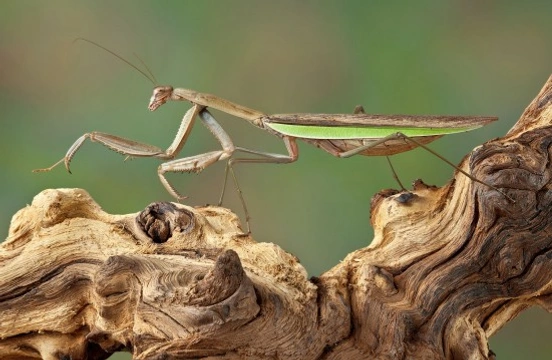
Is a praying mantis the right pet for you?
Mantises, or mantids, belong to an order of insects comprising over 2,000 species, with the praying mantis being one of the most well-known. The name stems from the appearance of their front legs, which are often held together as if in prayer. Sometimes called the "preying mantis" due to their hunting habits, these fascinating insects are carnivorous predators.
Various types of praying mantis can be kept as pets, including the hardy African praying mantis. Their appearances vary widely, from camouflaged twig-like forms to vibrant, beautiful colours and patterns. They typically range from 2 to 6 inches long, with pet mantids generally at the smaller end of the scale.
Praying mantises are relatively short-lived, usually surviving around six months. They provide a unique pet experience, especially for those interested in exotic insects and insect behaviour.
Housing and accommodating a praying mantis
Praying mantises are solitary creatures and should be kept alone. Their enclosures need not be large; a tank about one square foot is sufficient. Ventilation is critical, so a mesh top is preferable over a plastic or glass lid to allow fresh air.
The tank substrate should be a couple of inches deep, using soil peat or vermiculite mixed with sand to help retain moisture. The enclosure should be furnished with twigs, sticks, and possibly live plants, providing height for your mantis to hang while moulting. Avoid overcrowding decorations to ensure ample space for movement and hunting.
Temperature and lighting needs
Mantises are sensitive to temperature fluctuations. The African praying mantis is relatively sturdy, thriving best in a stable temperature range between 21 to 30 degrees Celsius. Because average UK room temperatures may be cooler, providing warmth with a heat mat under the substrate controlled by a thermostat is recommended. A thermometer will help you monitor and maintain the ideal temperature.
These insects generally avoid bright light and do not require supplementary lighting. Placing the enclosure away from direct sunlight or strong artificial light reduces stress.
Water and humidity requirements
Humidity is important, with many mantid species, such as the African praying mantis, requiring around 60% humidity. A shallow water dish with stones or a sponge prevents accidental drowning and helps maintain humidity levels. Regular misting with clean water also assists in keeping the enclosure humid but avoid over-saturating the substrate.
Diet: What do praying mantises eat?
Praying mantises are carnivores that hunt a variety of live insects including flies, crickets, and mealworms. These live foods are available from specialist exotic pet shops or online. The quality and nutrition of prey depend on what they have previously consumed.
To ensure your mantis receives essential nutrients, "gut loading" the live food with nutrient-rich solutions beforehand is vital. This process enhances the prey's nutritional value and, consequently, your pet mantis’s health.
While a water dish is recommended, mantises may hydrate themselves by drinking water droplets from the foliage or decorations, so don't be alarmed if you rarely see them drinking directly from the dish.
Where to find a praying mantis for sale
When purchasing a praying mantis, be certain about the species you are buying and understand its specific care needs. Specialist pet shops often stock praying mantises, but availability may be limited depending on your location.
Many enthusiasts breed mantids and offer them for sale via local groups or online communities specialising in invertebrates. For reliable options, check out the praying mantises for sale section on Pets4Homes.
Is a praying mantis the right pet for you?
A praying mantis can be a fascinating and unique pet, but it suits a particular type of owner. They are low-maintenance and quiet pets ideal for those interested in exotic invertebrates and insect behaviour. However, they have a short lifespan of six to twelve months and require live prey, which might not be suitable for everyone.
They are solitary and delicate animals, needing careful handling, so they may not be suitable for young children or those seeking a cuddly companion. Additionally, a praying mantis does not offer tactile affection but instead offers a rewarding experience through observation and understanding of its biology.
If you enjoy providing the precise care they need, are comfortable with their dietary requirements, and appreciate their unique behaviours, a praying mantis can be an enjoyable and intriguing pet.



